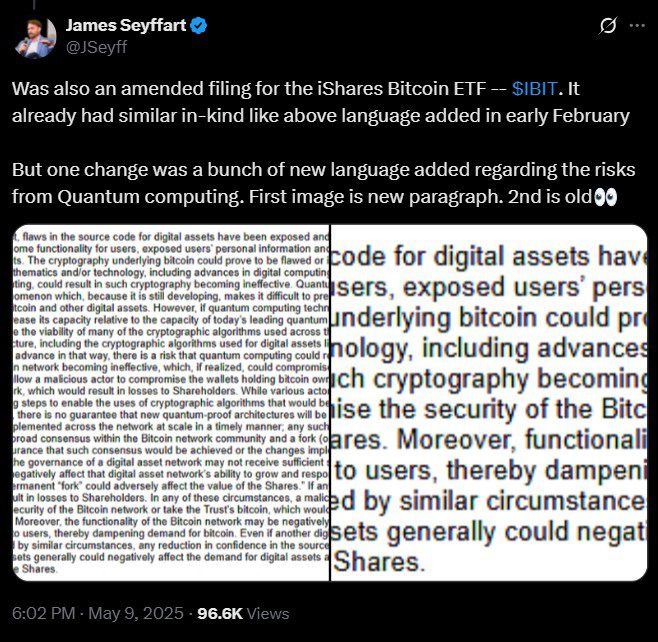BlackRock, the world’s largest asset manager, has identified quantum computing as a potential risk to the security of Bitcoin and other blockchain networks. This acknowledgment comes in a recent update to the registration statement for its iShares Bitcoin ETF (IBIT). While the risk is considered by many to be long-term, BlackRock’s mention highlights the evolving challenges facing the cryptocurrency space.
The Quantum Computing Threat to Bitcoin
Quantum computing, an emerging field leveraging quantum mechanics, promises significantly enhanced processing power compared to classical computers. This power, while revolutionary, poses a threat to current cryptographic algorithms that secure Bitcoin and other digital assets.
BlackRock stated that if quantum computing technology advances sufficiently, it “could potentially undermine the viability of many of the cryptographic algorithms used across the world’s information technology infrastructure, including the cryptographic algorithms used for digital assets like bitcoin.”
How Quantum Computing Could Break Bitcoin
Bitcoin’s security relies heavily on cryptographic hash functions and digital signatures. Quantum computers, using algorithms like Shor’s algorithm, could potentially break these cryptographic systems, allowing attackers to:
- Compromise private keys: Gaining access to Bitcoin wallets and transferring funds.
- Forge transactions: Creating fraudulent transactions on the blockchain.
- Disrupt the network: Potentially destabilizing the entire Bitcoin network.
BlackRock’s Disclosure and Industry Response
This marks the first time BlackRock has explicitly addressed the quantum computing risk in its IBIT disclosures. The IBIT ETF is the largest spot Bitcoin ETF, holding approximately $64 billion in net assets. This disclosure has prompted discussions within the cryptocurrency community.
James Seyffart, an analyst for Bloomberg Intelligence, noted that such risk disclosures are standard practice, highlighting potential risks, even if they are unlikely. He emphasized that it is completely standard for financial institutions to highlight any potential thing that can go wrong with any product they list or underlying asset that’s being invested in.
Bitcoin ETF Inflows and Market Sentiment
Despite the quantum computing concerns, Bitcoin ETFs have seen significant inflows since their launch in January. Data from Farside Investors reveals that Bitcoin ETFs have collectively attracted over $41 billion in net inflows.

On May 8, Bitcoin ETF net inflows surpassed all-time highs of around $40 billion, reflecting strong investor interest in Bitcoin exposure through traditional financial instruments.
Eric Balchunas, a Bloomberg Intelligence analyst, highlighted the importance of lifetime net flows as a key metric, stating, “Impressive, they were able to make it to a new high water mark so soon after the world was supposed to end.”
Potential Solutions and Mitigation Strategies
While quantum computing poses a potential threat, the Bitcoin community is actively exploring solutions. These include:
- Quantum-resistant cryptography: Developing new cryptographic algorithms resistant to quantum attacks.
- Hard forks: Upgrading the Bitcoin protocol to incorporate quantum-resistant cryptography.
- Hybrid approaches: Combining classical and quantum-resistant cryptography for enhanced security.
Tether CEO’s Perspective
In February, Tether CEO Paolo Ardoino suggested that quantum computing could eventually enable hackers to access inactive Bitcoin wallets and recover dormant coins. He stated, “Any Bitcoin in lost wallets, including Satoshi (if not alive), will be hacked and put back in circulation.”
The Future of Bitcoin Security
The potential threat of quantum computing to Bitcoin is a long-term concern, not an immediate crisis. However, BlackRock’s acknowledgement underscores the need for ongoing research and development in quantum-resistant cryptography. The Bitcoin community’s proactive approach to addressing this challenge suggests a strong commitment to the long-term security and resilience of the Bitcoin network.
What This Means for Investors
The key takeaways for investors are:
- Be Aware: Understand the potential long-term risks associated with quantum computing and Bitcoin.
- Stay Informed: Follow developments in quantum-resistant cryptography and potential Bitcoin protocol upgrades.
- Don’t Panic: This is not an immediate threat, and the Bitcoin community is actively working on solutions.

Ultimately, the future of Bitcoin security depends on the successful development and implementation of quantum-resistant solutions. The industry’s awareness and proactive approach provide a reason for optimism.